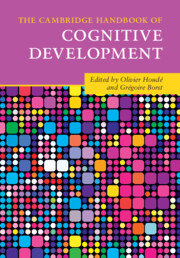Book contents
- The Cambridge Handbook of Cognitive Development
- The Cambridge Handbook of Cognitive Development
- Copyright page
- Contents
- Figures
- Tables
- Contributors
- Introduction
- Part I Neurobiological Constraints and Laws of Cognitive Development
- Part II Fundamentals of Cognitive Development from Infancy to Adolescence and Young Adulthood
- Introduction
- Subpart II.1 Infancy: The Roots of Human Thinking
- Subpart II.2 Childhood and Adolescence: The Development of Human Thinking
- 15 Development of Qualitative Thinking
- 16 Development of Numerical Knowledge
- 17 Numerical Cognition and Executive Functions
- 18 Developing Theory of Mind and Counterfactual Reasoning in Children
- 19 Development of Executive Function Skills in Childhood
- 20 Developing Cognitive Control and Flexible Adaptation during Childhood
- 21 Reasoning Bias and Dual Process Theory
- 22 Social Cognitive Development
- 23 Behavioral and Neural Development of Cognitive Control and Risky Decision-Making across Adolescence
- 24 The Triadic Neural Systems Model through a Machine-Learning Mill
- Part III Education and School-Learning Domains
- Index
- Plate Section (PDF Only)
- References
21 - Reasoning Bias and Dual Process Theory
Developmental Considerations and Current Directions
from Subpart II.2 - Childhood and Adolescence: The Development of Human Thinking
Published online by Cambridge University Press: 24 February 2022
- The Cambridge Handbook of Cognitive Development
- The Cambridge Handbook of Cognitive Development
- Copyright page
- Contents
- Figures
- Tables
- Contributors
- Introduction
- Part I Neurobiological Constraints and Laws of Cognitive Development
- Part II Fundamentals of Cognitive Development from Infancy to Adolescence and Young Adulthood
- Introduction
- Subpart II.1 Infancy: The Roots of Human Thinking
- Subpart II.2 Childhood and Adolescence: The Development of Human Thinking
- 15 Development of Qualitative Thinking
- 16 Development of Numerical Knowledge
- 17 Numerical Cognition and Executive Functions
- 18 Developing Theory of Mind and Counterfactual Reasoning in Children
- 19 Development of Executive Function Skills in Childhood
- 20 Developing Cognitive Control and Flexible Adaptation during Childhood
- 21 Reasoning Bias and Dual Process Theory
- 22 Social Cognitive Development
- 23 Behavioral and Neural Development of Cognitive Control and Risky Decision-Making across Adolescence
- 24 The Triadic Neural Systems Model through a Machine-Learning Mill
- Part III Education and School-Learning Domains
- Index
- Plate Section (PDF Only)
- References
Summary
If you are racing toward a cliff or a steep mountain drop-off, the sensible thing to do is to slow yourself down and stop – and as a matter of some urgency. Braking in this case is natural and intuitive. Yet, when you are hang gliding, not only should you not slow down as you approach a cliff, it is important that you accelerate, gaining velocity with every single stride as you approach the drop-off in order to have the necessary wind speed to fly. In the last moments before flight, you should be nearly sprinting toward the edge. For many aspiring hang gliders this can be quite challenging. A successful hang glide start requires you to override your intuitive tendency to stop when seeing a cliff. Although this natural “stopping” intuition is usually very useful, failing to control it when needed can have dramatic consequences.
- Type
- Chapter
- Information
- The Cambridge Handbook of Cognitive Development , pp. 472 - 480Publisher: Cambridge University PressPrint publication year: 2022



